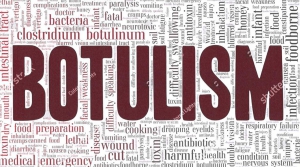Botulism
What is Botulism?
 Botulism is a rare muscle-paralyzing illness caused by a nerve toxin produced by a bacterium called Clostride botulinum. There are three naturally occurring kinds of botulism:
Botulism is a rare muscle-paralyzing illness caused by a nerve toxin produced by a bacterium called Clostride botulinum. There are three naturally occurring kinds of botulism:
- foodborne botulism caused by eating toxin-contaminated food. No instances of waterborn botulism have ever been reported.
- wound botulism caused by toxin production in a wound infected with Clostridium botulinum. The botulinum toxin does not penetrate intact skin.
- intestinal botulism caused by ingesting foods contaminated with spores of the Clostridium botulinum. The spores grow and develop into the bacteria, which release botulinum toxin in the intestines.
Inhalational botulism is a man-made kind of botulism that results when the botulinum toxin is distributed in an aerosol form, and is thought to be the most likely form that would be used by bioterrorists. When aerosolized, botulinum toxin is the most poisonous substance known.
What are the symptoms of botulism?
Once botulinum toxin is absorber, either in the lungs or intestines, the bloodstream circulates the toxin, delivering it throughout the body. The toxin acts on the nerves that supply muscles, interrupting communication between the brains and muscles. All forms of human botulism have virtually the same symptoms:
- Double or blurred vision; drooping eyelids.
- Slurred speech; difficulty swallowing; dry mouth.
- Muscle weakness that begins at the shoulders and travels down the body.
- Paralysis of muscles involved in breathing will cause a person to stop breathing and die unless breathing assistance is provided.
How soon after exposure would symptoms begin?
The speed at which symptoms would occur and the severity of botulism is dependent upon the amount of toxin absorbed.
- Symptoms of foodborne botulism typically begin within 12-72 hours but could be seen as early as 2 hours or as late as 8 days after ingesting the toxin.
- An accidental exposure to an unknown amount of aerosolized botulinum toxin produced symptoms approximately 72 hours after inhalation exposure.
Can botulism be spread person to person?
Botulism is not spread person to person.
Can botulism be treated?
Early recognition and active management is key to patient recovery. Affected persons require rapid administration of antitoxin. Patients with respiratory compromise need respiratory support.
How likely is it that I will be exposed to botulism or another biological agent?
Naturally occurring botulism is extremely rare and only 3 cases of inhalational botulism have ever been described. Historically, in the United States, the individual risk of disease due to a bioterrorism attack has been very, very low.
How could an intentional release of botulinum toxin be managed?
State and local public health, emergency, and law enforcement agencies will work together to evaluate all incidents. Examining the circumstances of the incident, the suspect material, and the type of exposure is required to determine if the incident represents a public health risk.
Botulism Information for Public Health Officials
Pre-formed bacterial toxin
Unique Epidemiological Characteristics
- Natural reservoir for the bacteria is soil
- A newly reported case should be urgently investigated considering:
- Foodborne (intentional or unintentional)
- Wound
- Aerosol (intentional)
- Incubation: 12-72 hours; sometimes longer
- No person-to-person transmission
- Mortality: very high (without therapy) due to respiratory muscle paralysis – dire emergency
- Environmental:
- Aerosolized toxin decays at about 1-4% per minute – not environmentally stable
- Foods can continue to be a source as long as they are in circulation
- Prophylaxis – not available
- Treatment – antitoxin + artificial respiration – effective if initiated early
Lab confirmation
- Virginia State Health Department
- Implications: Use a clinical case definition early in the investigation: diplopia, dysarthria, dysphonia, dysphagia
Employee Health Considerations
- Exposed employees should be placed under surveillance for development of symptoms
- Standard precautions for work with affected individuals
Lifesaving interventions – in order:
- Recognition / reporting / casefinding + early and appropriate therapy
- Collect and analyze risk information to identify source AND
- remove source (e.g., food) from the environment AND
- identify the exposed population to be placed under surveillance.
Training considerations
- Physicians: recognition / treatment / reporting
- ICPs: reporting, active surveillance procedures
- Labs: procedure for referral of specimens
- Local health departments, regional epidemiologists: investigation
- IDEP / DSDC / BPH: employee health / investigation / priorities for control
- Environmental Health: sampling of foods and other environmental specimens
